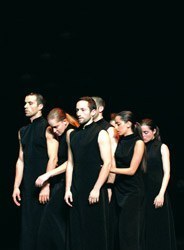
There are dances I can’t even fathom disliking. But I can understand not liking Israeli choreographer Emanuel Gat’s thoroughly down to earth approach to Mozart’s Requiem, the composer’s final appeal to God and death. The disconnect between music and steps–pedestrian gestures repeated like musical motifs and Janet Jackson steps so tight they’re rubbing against each other the way a cat rubs against the furniture or your leg–might seem like sheer impudence. But I think Gat had something serious (and respectful) in mind.
He was too musical to offend me. Hypermusical. He hears like Balanchine, except more emphatically, more obsessively. He hears almost the way some autistics see. His sensitivity didn’t just show up in the steps’ rhythms–the heavy downbeats, for example, in Mozart’s long, fearsome arcs to Heaven–but in how many dancers clustered together, or how they peeled off from the group, or how quietly or loudly they rolled their shoulders or their hips. It was like watching someone pick up what looks like a rock and crumble it so you see it’s earth. Every time he’d crumble the rock of Mozart’s Requiem, my heart would break open with joy.
I didn’t think it was perfect: If the choreography were writing, you’d be wondering if it were using direct or indirect address. But the diction was consistent, and it was pleasing the way particular steps would return.
I imagined him setting up an experiment for himself: If I abstract the story from this music, if I translate it into purely visual and kinetic terms, what will be left of that story, its terror and awe? Will it seep in anyway? Will I even be able to keep it out?
I think that’s a brave and interesting experiment. But if the answers had been “no”–no, there is no relation between this huge music and our unassuming patterns down below–it wouldn’t have been worth putting on stage. Gat lucked out.
Gat’s “K626” is at the Joyce through Sunday.
UPDATE: I found this lovely review on the invaluable ballet.co.uk site. (It compiles all sorts of English-language reviews in all sorts of dance genres. A wonderful resource.) It’s two days since I wrote the post above, and the dance is sticking: images (for example, the moment pictured above, when certain dancers slipped inside the cracks between other dancers, like when you’re in a packed crowd and trying to glimpse the famous speaker or when you’re waiting at the end of time) keep reappearing to me.

Leave a Reply